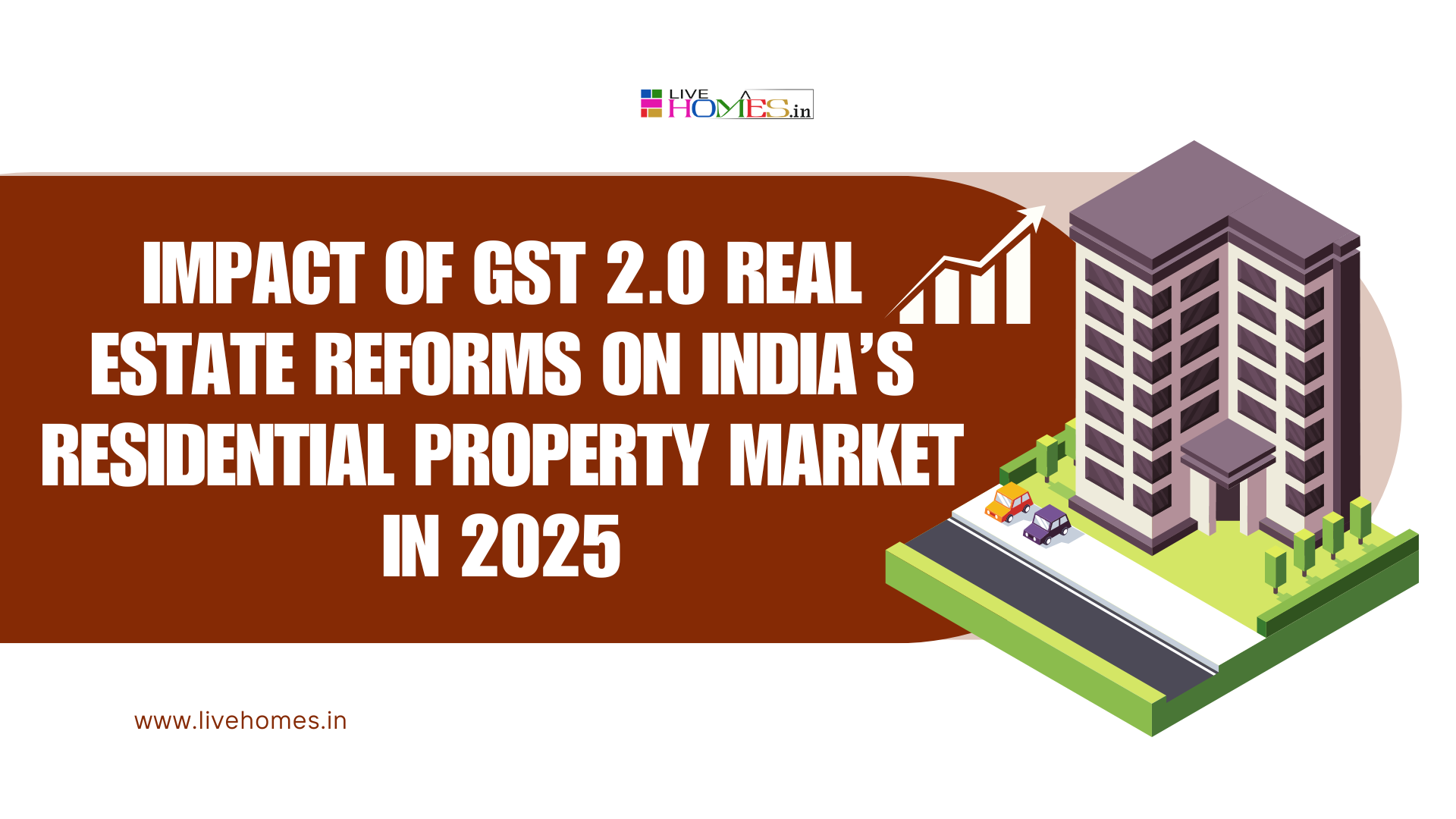India's residential real estate market has undergone various transformations over the years, with the introduction of Goods and Services Tax (GST) in 2017 being a significant milestone. However, the recent developments surrounding GST 2.0—set to be implemented in 2025—are expected to further reshape the landscape of the real estate sector.
In this article, we will explore how the GST 2.0 reforms will impact India’s residential real estate market, specifically focusing on key changes, their potential consequences for homebuyers, developers, and investors, and how they might affect the overall growth of the industry.
1. What is GST 2.0?
GST 2.0 refers to a series of reforms aimed at streamlining and improving India’s Goods and Services Tax framework. The main objective of GST 2.0 is to make the tax system more efficient, transparent, and conducive to economic growth. As the residential real estate sector is one of the most significant contributors to the economy, these reforms will likely play a crucial role in its future trajectory.
Some of the proposed changes include:
- Revised tax rates: The introduction of simplified tax slabs with an emphasis on rationalizing GST rates for various sectors, including real estate.
- Tax credit adjustments: Enhanced mechanisms for input tax credit claims, potentially making it easier for developers to reduce tax burdens and pass savings to consumers.
- Standardization of taxes: Measures aimed at harmonizing taxes between states and union territories to ensure seamless tax administration.
- Digitization and compliance: Further improvements in digital tax filings, making it easier for stakeholders to comply with GST norms.
2. Impact on Residential Real Estate Market: Homebuyers
One of the primary groups affected by the implementation of GST 2.0 will be homebuyers. The reforms could lead to several significant changes:
a. Reduction in GST Rates:Under the current GST structure, residential real estate transactions are subject to tax rates that range from 5% to 18%, depending on the nature of the property and whether it is under construction or completed.
In GST 2.0, it is expected that the tax rate for under-construction properties will be further reduced, making homes more affordable for buyers. If the proposed GST rate for housing is lowered to around 5% or below, homebuyers can benefit from reduced overall costs.
Additionally, any input tax credits claimed by developers on raw materials or construction services could be passed on to the buyers, potentially reducing property prices.
b. Simplification of the Homebuying Process:
The implementation of a more simplified tax filing process can reduce confusion for buyers and developers alike. GST 2.0 is expected to make it easier for buyers to navigate the taxation structure and ensure that they’re not overpaying or subject to unnecessary delays in documentation. This will bring in greater transparency to the system, fostering greater trust in the residential real estate market.
c. Property Prices:
If GST 2.0 leads to a more streamlined tax structure with clearer definitions and better tax credits for developers, it could result in a drop in property prices over time. This could be especially beneficial for middle-class and first-time homebuyers, who have faced the brunt of high home prices in recent years.
d. Ready-to-Move-In Properties:
In the current scenario, ready-to-move-in properties are exempt from GST, but under-construction properties are subject to the tax. If GST 2.0 introduces more favorable taxation for ready-to-move-in properties (perhaps including some tax benefits or reductions), it could encourage more buyers to opt for completed homes instead of under-construction projects, accelerating market liquidity.
3. Impact on Developers and Builders
For real estate developers, the new GST 2.0 reforms are expected to have both positive and negative implications.
a. Input Tax Credit Benefits:
GST 2.0 is expected to introduce more efficient input tax credit mechanisms, making it easier for developers to claim credits on goods and services used in the construction of residential properties. This could reduce the overall cost burden on developers, allowing them to pass on savings to customers in the form of lower prices.
b. Tax Burden and Compliance:
While the simplification of GST filings is a positive, compliance with these rules can be time-consuming and costly for smaller developers. In a highly competitive market like India’s real estate, the administrative costs of staying compliant with GST 2.0 might add another layer of complexity for developers with limited resources.
c. Reduced Operational Costs:
The lowering of GST rates on construction materials and services could lower operational costs for developers. This could result in a reduction in the overall cost of construction, making it more viable to launch new residential projects. Additionally, developers might focus on building affordable housing given the growing demand and the financial incentives from GST 2.0.
d. Increased Demand for Affordable Housing:
The GST 2.0 reforms are likely to drive more developers to focus on the affordable housing segment, which has seen increased demand due to government incentives like the Pradhan Mantri Awas Yojana (PMAY) and rising urbanization. With lower tax burdens and streamlined procedures, developers may find it easier to enter this market, boosting the construction of more homes for the lower and middle-income groups.
4. Impact on Real Estate Investors
For real estate investors, the introduction of GST 2.0 presents both opportunities and challenges.
a. Increased Investment in Residential Projects:
With the possibility of lower GST rates, investors might see an attractive opportunity in the residential real estate sector. A reduction in the cost of construction and improved tax efficiencies could lead to better margins for developers, which may attract more capital to the sector.
b. More Transparent Market Dynamics:
The increased digitization and standardization of the GST system under GST 2.0 will likely create a more transparent and predictable real estate market. Investors could benefit from clearer regulations and better insight into the market, enabling smarter investment decisions.
c. Impact on Rental Yields:
The effect of GST 2.0 on rental yields could vary depending on the state. The introduction of favorable tax rates could make residential properties more affordable, leading to higher demand for rental properties. Consequently, rental yields may see a positive impact, making the sector more attractive for long-term investors.
5. Broader Economic Impact
a. Growth in Real Estate Construction:
The reduction in GST rates and the simplification of the tax system may lead to increased construction activity in the residential real estate market. As the cost of construction reduces, developers may be encouraged to launch more projects, thereby increasing the supply of homes. This could ease the chronic housing shortage in urban areas and stimulate economic growth in the real estate sector.
b. Increased Housing Affordability:
The goal of GST 2.0 is not only to streamline taxes but also to make housing more affordable for the average Indian consumer. A reduction in the overall tax burden could lower home prices, particularly in high-demand urban markets, allowing more people to own homes. This would have a significant social impact by improving homeownership rates.
c. Impact on Rural and Urban Divide:
GST 2.0 could also play a role in bridging the gap between rural and urban real estate markets. By incentivizing affordable housing in both urban and rural areas, the reforms may reduce the rural-urban divide in housing standards and availability.
Conclusion
The implementation of GST 2.0 in 2025 will likely mark a pivotal moment for India's residential real estate market. While the reduction in GST rates, improved input tax credits, and greater transparency will bring significant benefits to homebuyers, developers, and investors, the full impact will depend on the specific details of the reforms. If implemented effectively, GST 2.0 has the potential to increase affordability, reduce project timelines, and drive sustainable growth in the residential real estate market, which could ultimately have a positive ripple effect on India's broader economy. However, developers and investors will need to stay agile, adapting to the new tax system and ensuring that they remain compliant with the revised regulations. As the real estate sector continues to evolve, the residential market is poised for a shift, and GST 2.0 will play a critical role in defining its future.
https://www.livehomes.in/blogs













